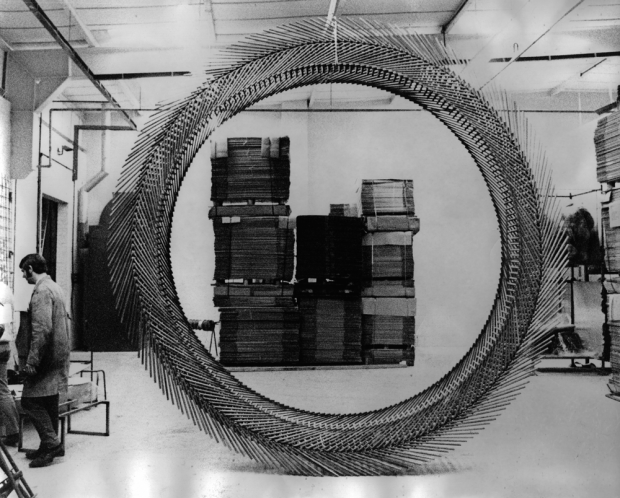
Artists have a long legacy of getting wrapped up with politics and social issues.
But the most radical incidence of artists attempting to change society at a political level began in the 1960s, when a group of conceptual artists started working in various government departments. Inside the walls of the British civil service and industry, the practice saw artists attempting to infiltrate the British social and political landscape like we’d never seen before.
The practice, known as “least events”, was an attempt to bridge the gap between society and art by physically inserting artists into businesses and corporations, in the hope that by giving them a contracted position their presence would have a lasting impact on the institution and it’s employees. High-ranking trustees such as Tony Benn MP (then a cabinet member) and Frank Martin, the head of sculpture at Central Saint Martins and the then Director of the Design Council, played a significant part in securing funding and assignments for the artist agency.
The collective, Artist Placement Group, was set-up in London during the 1960s, by couple John Latham and Barbara Steveni. Latham had started to produce some controversial works, that sometimes got him into trouble. In 1966, whilst working as a part-time lecturer at Central Saint Martins School of Art, he and his then student Barry Flanagan borrowed a copy of Clement Greenberg’s seminal text Art and Culture from the university library. Later, during a house party, Latham and Flanagan gave each guest a page torn from the book and asked them to chew it. The chewed paper was then collected, fermented, distilled into alcohol and placed in a vial. Latham returned the vial to the library when the overdue book was finally requested and subsequently lost his job.
John Hill, the Education Officer at the studio home of John Latham, now a museum, explains the concept behind CHEW as; “A response to Greenberg’s formalist ideas that still dominated British art schools, and a riposte to Greenberg’s comment that British art was in ‘too good taste’. Latham and Flanagan wondered what Greenberg tasted like.”
During that period, artists universally were beginning to explore new, innovative ways of exploring arts and science. In America, the artist collective Experiments in Art and Technology (E.A.T) founded by Billy Klüver, and Fred Waldhauer - both electrical engineers at Bell Telephone Laboratories, and the artist Robert Roushenberg, were gaining recognition for facilitating the work of artists who wanted to create avant-garde work using new technologies.
In 1968 APG set about organising their first event, the Industrial Negative Symposium in London, which included Klüver and E.A.T. This collaborative process slowly turned into a sort of artists’ agency, and APG began setting-up their placement scheme. One of the artists who undertook an APG placement was Stuart Briesly. Breisly was an active member of APG from 1967-71, but after becoming disillusioned with the group’s ideals of engineering policy at a direct level, he handed in his resignation. He felt that Latham’s ideologues were not sustainable. The group’s desire to dramatically reshape and direct the county’s politics was no longer about exploring artistic practice but about dominance and control.
Brisley undertook one placement with APG, at Hille furniture factory.
“At Hille, I first worked on the shop floor. I looked around the different departments of the factory, but what appeared to be the most different was the polishing workshop, that’s where I chose to work.” Explains Brisley.
“I had to get to know the workforce, which was difficult. Hille furniture were making interesting products, like the classic Bauhaus chairs, but the people working on the factory lines had no idea.”
After experiencing a disconnect between the workers and the end product, Brisley set about trying to change the working environment. After speaking with management, he came up with the idea of encouraging the employees on the polishing floor to decorate their machines, in an attempt to engage them in the creative process. The end result was a series of heavy-duty machinery painted with the colours of their favourite football teams.